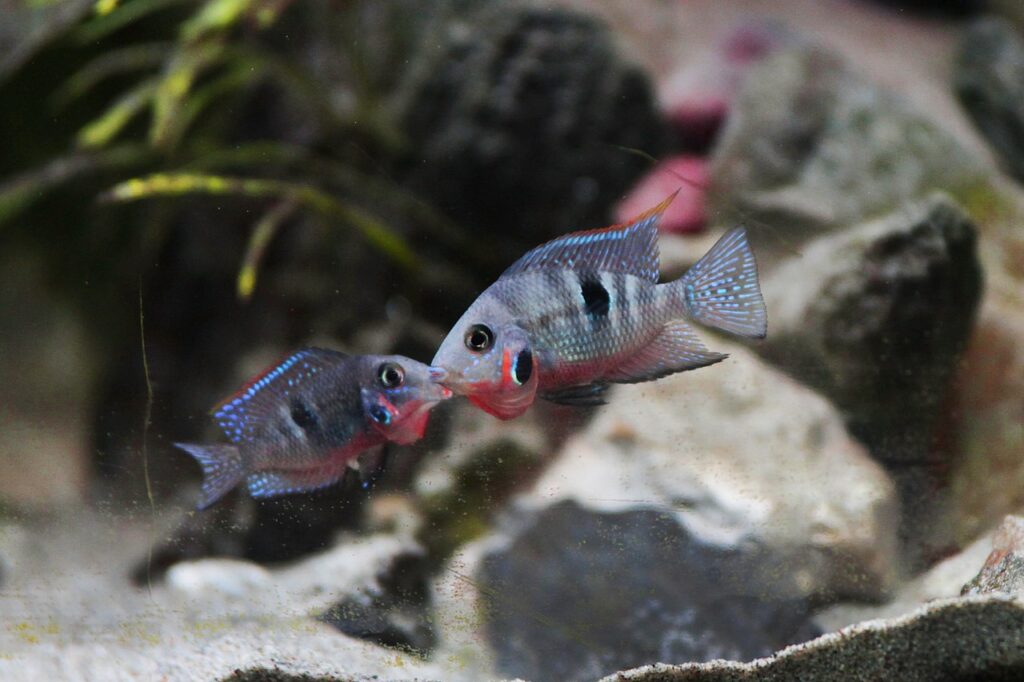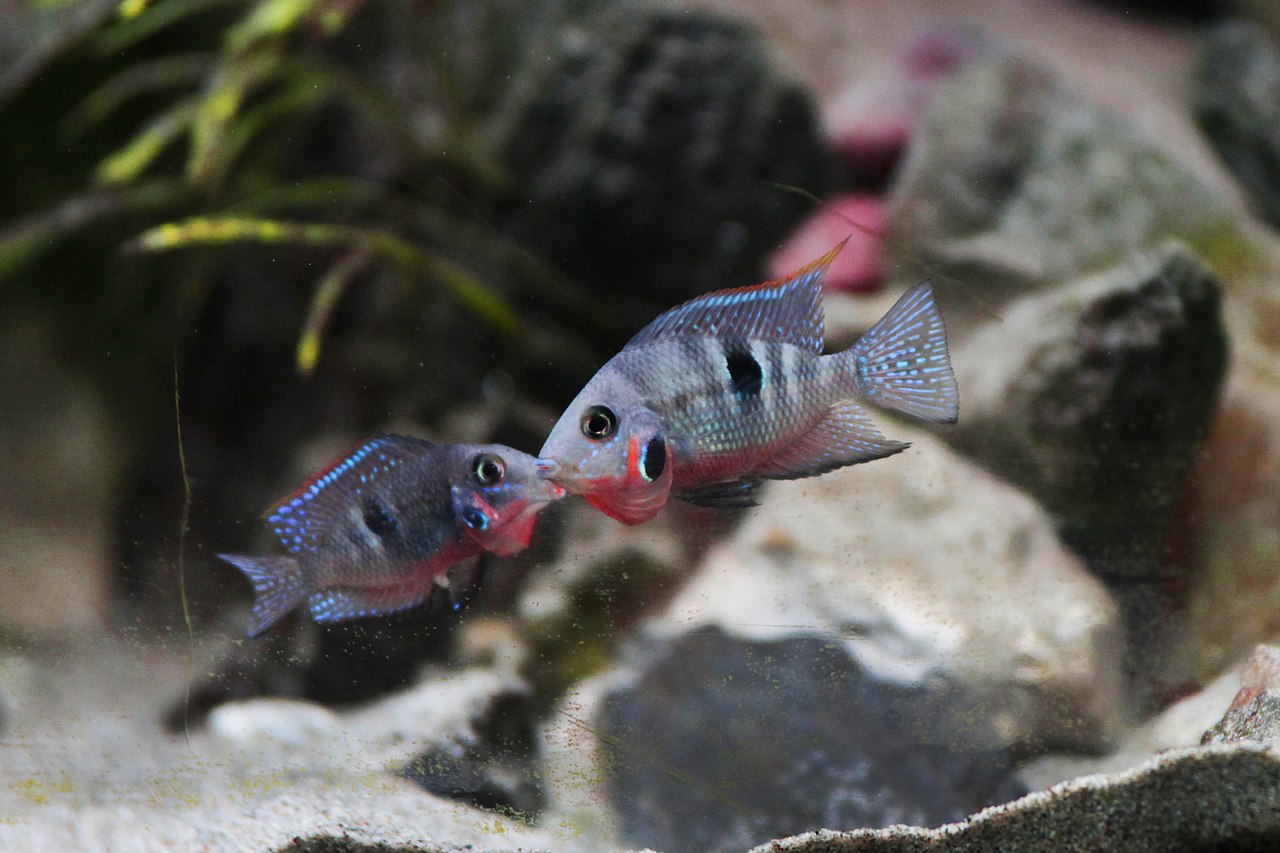Dive into the vibrant world of the Firemouth Cichlid. These freshwater gems, with their dazzling colors, have charmed fish hobbyists for years. Native to Central America, their scientific name, Thorichthys meeki, hails from the Cichlidae family. Sharing a family with over 1,600 species, their closest relatives include well-known aquarium regulars like the Oscar and the Convict Cichlid. But what truly sets the Firemouth apart? Their unique bright blue bodies are adorned with a radiant red underside, especially around the throat, giving them their fiery moniker.
Table of Contents
Are you worried about the rarity of these fish? Fear not! Firemouth Cichlids are quite common in the aquarium trade, standing out as a favored choice for those who adore Central American cichlids. While there aren’t significant variants, slight color differences can sometimes be spotted based on factors such as diet and water conditions.
Understanding the Firemouth Cichlid’s natural habitat is crucial for any hobbyist. They originate from slow-moving waters in areas like the Yucatan Peninsula. In your aquarium, expect them to be primarily bottom to mid-dwelling residents. With an omnivorous diet, these cichlids enjoy a mix of invertebrates, crustaceans, and plant matter in the wild. To guarantee the welfare and happiness of the animals in captivity, it is crucial to offer them a well-balanced diet that includes high-quality flake food and pellets. Additionally, providing them with occasional live or frozen treats like brine shrimp will be a delightful indulgence. While they are often peaceful, remember, they have a territorial side, especially during breeding seasons.
Let’s talk numbers! These radiant fish typically reach up to 6 inches in length and can live up to a decade with proper care. Now, isn’t that impressive?
Interesting facts about the Firemouth? Their defensive stance is unique. Instead of outright aggression, they’ll flare their red gills and throat, thrusting it toward a rival or potential threat. This behavior is also prominently displayed during courtship rituals. And, if you’re looking to breed, know that they are cave spawners, often choosing overturned pots or caves in aquariums to lay their eggs.
Why is it called “Firemouth”? Just to add a hint of excitement. It’s all about the display! When threatened or during courtship, their throat and gills become even more stunning and captivating, creating the mesmerizing illusion of a mouth engulfed in a breathtaking blaze of vibrant red.
Lastly, a glimpse into their past. The Firemouth Cichlid was first introduced to the world by Walter Brind in 1918. Over the centuries, their popularity has only surged, making them a staple in the world of aquarium enthusiasts.

Firemouth Cichlid: An Aquarium Enthusiast’s Guide
The Firemouth Cichlid, a radiant gem from Central America, has long been a favorite among aquarium enthusiasts. Known for its vivid blue body and fiery red throat, it provides a dash of color and charm to any tank. If you’re thinking about introducing this mesmerizing species into your aquarium, this comprehensive table offers an extensive guide to assist you in comprehending all the necessary information for successfully caring for a sturdy and flourishing Firemouth Cichlid.
| Family | Cichlidae |
| Price | Varies, usually between $6-$15 depending on size and retailer |
| Common Names | Firemouth, Red-throated Cichlid |
| Variants | Slight color variations based on factors such as diet and water conditions |
| Ideal Tank Size | Minimum 30 gallons for a pair |
| Water Parameters | pH: 6.5-8.0, Temperature: 75-80°F (24-27°C), Hardness: 8-15 dGH |
| Lifespan | Up to 10 years with proper care |
| Full Size | Up to 6 inches (15 cm) |
| Natural Environment | Slow-moving waters in Central America |
| Behavior | Mostly peaceful but can be territorial, especially during breeding |
| Habitat Preference | Bottom to mid-dwelling |
| Aquarium Decoration | Rocks, driftwood, caves for hiding and spawning |
| Ideal Tank Mates | Corydoras, Tetras, Livebearers, other non-aggressive species |
| Fish to Avoid | Larger, aggressive species such as Oscars, aggressive Barbs |
| Best Foods/Diet | High-quality flake food, pellets, brine shrimp, bloodworms |
| Disease | Susceptible to common fish diseases like Ich; ensure clean water and quarantine new arrivals |
| Sex-Switch | No known sex-switch behavior |
| Gender Differences | Males are generally larger, with more pronounced colors; females may be plumper during breeding season |
| Care Level | Moderate – regular water changes, balanced diet, and appropriate tank mates are essential |
| Breeding Level | Moderate to hard – they are cave spawners and can be picky about their spawning sites |
Turn your aquarium into an enchanting sanctuary by acquiring the essential knowledge and providing adequate care for the mesmerizing Firemouth Cichlid, enhancing the allure of your aquatic paradise. Prepare to be captivated by these mesmerizing creatures with their vibrant colors and unique behaviors. Prepare yourself to plunge into the captivating realm of fish-keeping, where these mesmerizing creatures not only capture your attention but also completely submerge you in their enthralling world.
Ideal Tank Mates
Introducing the Firemouth Cichlid to your aquarium means ensuring you have suitable tank mates to create a harmonious environment. Firemouth Cichlids, being mostly peaceful but territorial during breeding, require companions that can coexist without triggering aggressive behaviors. The most effective tank companions tend to be less aggressive and establish individual territories, which minimizes territorial conflicts. Here’s a detailed look at 10 ideal companions for your Firemouth Cichlid:
- Corydoras
These small, armored catfish are bottom dwellers and are known for their peaceful nature. They scavenge for food and help in keeping the substrate clean. Their gentle demeanor ensures they don’t pose a threat to or irritate the Firemouths. - Tetras
Mid to upper tank swimmers, species such as the Neon Tetra or Rummy Nose Tetra gracefully navigate the waters. Their small size and schooling nature make them less likely to be viewed as threats, ensuring a colorful, dynamic tank. - Livebearers
Fish like Guppies, Mollies, and Platies add vibrancy to your aquarium. They are peaceful and tend to occupy the upper regions of the tank, reducing territorial disputes. - Angelfish
While they are also cichlids, Angelfish generally coexist peacefully with Firemouths, especially in larger tanks. Their slow, graceful movements and tall fin structure make them an aesthetic addition. - Dwarf Gouramis
These fish are calm and add a splash of color to the tank. They prefer the upper sections of the tank, and their labyrinth organ allows them to gulp air, a unique behavior to watch. - Rainbowfish
Known for their striking colors, Rainbowfish are schooling fish that prefer the middle and upper sections of the tank. Their active nature adds life and movement to the aquarium. - Plecos
These are another group of catfish that can coexist well with Firemouths. They are primarily bottom dwellers and are useful for algae control. However, ensure you select smaller species like the Bristlenose Pleco to avoid overcrowding. - Rasboras
These are small, schooling fish, and their peaceful nature makes them suitable tank mates. The Harlequin Rasbora, with its vibrant coloration, is an excellent choice. - Loaches
Fish like the Kuhli Loach or the Clown Loach are peaceful and have a unique appearance. They tend to be bottom dwellers, weaving through substrate and decorations. - Swordtails
These are livebearers with a striking, elongated lower fin. They are peaceful and tend to stay in the middle to upper sections, making them less likely to cross paths with the Firemouths.
When planning your aquarium, it’s vital to consider the space each species requires and the overall tank size. Providing plenty of hiding spots and ensuring a balanced diet for all inhabitants will promote a peaceful and thriving environment.
FAQs
How can I differentiate between a juvenile and an adult Firemouth Cichlid?
Juvenile Firemouth Cichlids are typically less vibrant in color, and their trademark fiery red throat isn’t as pronounced. As they mature, their colors will intensify, especially the red on their throat and undersides.
Is there a specific water flow preference for the Firemouth Cichlid?
Firemouth Cichlids hail from slow-moving waters, so they generally prefer a gentle water flow in the aquarium. Using filters that allow adjustable flow rates can be beneficial.
How do I set up a breeding environment for them?
While they aren’t overly fussy, Firemouth Cichlids appreciate a dimly lit tank with soft, slightly acidic water when breeding. Including flat stones or overturned pots can act as potential spawning sites.
Do Firemouth Cichlids have any specific molting or shedding behavior?
Unlike some aquatic species, Firemouth Cichlids don’t molt or shed. If you notice excessive skin or scale shedding, it could be a sign of a health issue or a response to poor water conditions.
Are there any specific sounds or noises Firemouth Cichlids make?
While they aren’t known for making audible sounds, Firemouth Cichlids, like many cichlids, are capable of producing low-frequency sounds, especially during aggressive or courting displays. However, these sounds are generally not audible to humans without special equipment.
How do Firemouth Cichlids respond to seasonal changes?
In their natural habitat, Firemouth Cichlids might experience variations in water parameters and food availability with the changing seasons. In an aquarium setting, they can be quite adaptive, but it’s beneficial to mimic a seasonal cycle, potentially inducing breeding behavior in the warmer “months.”
Can Firemouth Cichlids coexist with invertebrates like snails or shrimp?
Generally, smaller invertebrates like shrimp might become prey, especially if they’re small enough to fit in the Firemouth’s mouth. However, larger snails might coexist without much issue, provided the tank environment is spacious and there’s no competition for food.
What measures can help reduce the aggressive behavior of Firemouth Cichlids during breeding?
Providing ample hiding spots, using tank dividers, or even temporarily relocating the more aggressive individual can help. It’s essential to monitor the tank during breeding to ensure no fish is overly stressed or harmed.

Leave a Reply